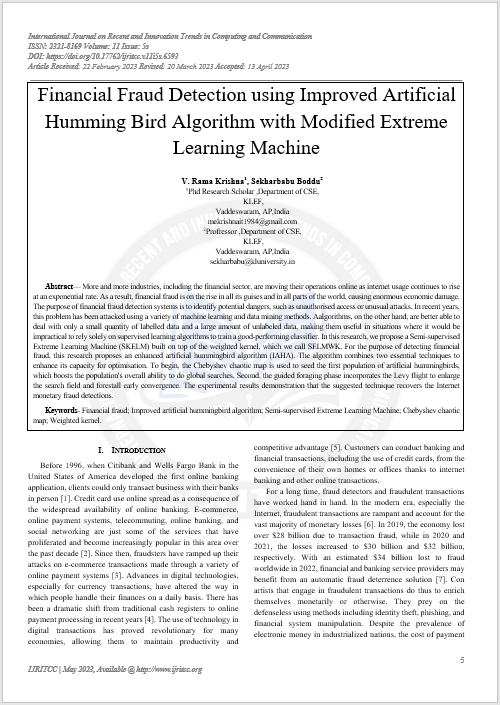Financial Fraud Detection using Improved Artificial Humming Bird Algorithm with Modified Extreme Learning Machine
Main Article Content
Abstract
More and more industries, including the financial sector, are moving their operations online as internet usage continues to rise at an exponential rate. As a result, financial fraud is on the rise in all its guises and in all parts of the world, causing enormous economic damage. The purpose of financial fraud detection systems is to identify potential dangers, such as unauthorised access or unusual attacks. In recent years, this problem has been attacked using a variety of machine learning and data mining methods. Aalgorithms, on the other hand, are better able to deal with only a small quantity of labelled data and a large amount of unlabeled data, making them useful in situations where it would be impractical to rely solely on supervised learning algorithms to train a good-performing classifier. In this research, we propose a Semi-supervised Extreme Learning Machine (SKELM) built on top of the weighted kernel, which we call SELMWK. For the purpose of detecting financial fraud, this research proposes an enhanced artificial hummingbird algorithm (IAHA). The algorithm combines two essential techniques to enhance its capacity for optimisation. To begin, the Chebyshev chaotic map is used to seed the first population of artificial hummingbirds, which boosts the population's overall ability to do global searches. Second, the guided foraging phase incorporates the Levy flight to enlarge the search field and forestall early convergence. The experimental results demonstration that the suggested technique recovers the Internet monetary fraud detections.
Article Details
References
Srokosz, M., Bobyk, A., Ksiezopolski, B. and Wydra, M., 2023. Machine-Learning-Based Scoring System for Antifraud CISIRTs in Banking Environment. Electronics, 12(1), p.251.
Alwadain, A., Ali, R.F. and Muneer, A., 2023. Estimating Financial Fraud through Transaction-Level Features and Machine Learning. Mathematics, 11(5), p.1184.
Fanai, H. and Abbasimehr, H., 2023. A novel combined approach based on deep Autoencoder and deep classifiers for credit card fraud detection. Expert Systems with Applications, p.119562.
Mayo, K., Fozdar, S. and Wellman, M.P., 2023. Flagging Payments for Fraud Detection: A Strategic Agent-Based Model.
GRADXS, G.P.B. and RAO, N., 2023. Behaviour Based Credit Card Fraud Detection Design And Analysis By Using Deep Stacked Autoencoder Based Harris Grey Wolf (Hgw) Method. Journal of Information Systems, 35(1), pp.1-8.
Lukman, R.P. and Chariri, A., 2023. THE ROLE OF INTERNAL AUDITORS IN FRAUD PREVENTION AND DETECTION: EMPIRICAL FINDINGS FROM GENERAL BANKING. Diponegoro Journal of Accounting, 12(1).
Strelcenia, E. and Prakoonwit, S., 2023. Improving Classification Performance in Credit Card Fraud Detection by Using New Data Augmentation. AI, 4(1), pp.172-198.
Dammavalam, S.R. and Mukheed, M., Credit Card Fraud Detection Using Machine Learning.
Dolu, U., 2023. A novel sampling technique and gradient boosting tree-based approach for cross-channel fraud detection.
Sharma, K., 2023. Fraud Detection Model Using Semi-supervised Learning. In Soft Computing for Problem Solving: Proceedings of the SocProS 2022 (pp. 395-406). Singapore: Springer Nature Singapore.
Okaka, J.M., 2023. Examination of fraud in the Ugandan banking sector and its prevention: a case study of Post Bank Uganda Limited (Doctoral dissertation, Makerere University).
Zakaria, P., 2023. Financial Inclusion to Digital Finance Risks: A Commentary on Financial Crimes, Money Laundering, and Fraud. In Financial Technologies and DeFi: A Revisit to the Digital Finance Revolution (pp. 123-130). Cham: Springer International Publishing.
Owiti, S.O., Ogara, S. and Rodrigues, A., 2023. CONTRIBUTING FACTORS TO MOBILE FINANCIAL FRAUD WITHIN KENYA. EPRA International Journal of Research and Development (IJRD), 8(1), pp.32-39.
Xu, B., Wang, Y., Liao, X. and Wang, K., 2023. Efficient Fraud Detection using Deep Boosting Decision Trees. arXiv preprint arXiv:2302.05918.
Fanai, H. and Abbasimehr, H., 2023. A novel combined approach based on deep Autoencoder and deep classifiers for credit card fraud detection. Expert Systems with Applications, p.119562.
Xu, M., Fu, Y. and Tian, B., An ensemble fraud detection approach for online loans based on application usage patterns. Journal of Intelligent & Fuzzy Systems, (Preprint), pp.1-14.
Alwadain, A., Ali, R.F. and Muneer, A., 2023. Estimating Financial Fraud through Transaction-Level Features and Machine Learning. Mathematics, 11(5), p.1184.
Van Belle, R., Baesens, B. and De Weerdt, J., 2023. CATCHM: A novel network-based credit card fraud detection method using node representation learning. Decision Support Systems, 164, p.113866.
Teng, H., Wang, C., Yang, Q., Chen, X. and Li, R., 2023. Leveraging Adversarial Augmentation on Imbalance Data for Online Trading Fraud Detection. IEEE Transactions on Computational Social Systems.
Akinbowale, O.E., Mashigo, P. and Zerihun, M.F., 2023. The integration of forensic accounting and big data technology frameworks for internal fraud mitigation in the banking industry. Cogent Business & Management, 10(1), p.2163560.
Zhou, H., Sun, G., Fu, S., Wang, L., Hu, J. and Gao, Y., 2021. Internet financial fraud detection based on a distributed big data approach with node2vec. IEEE Access, 9, pp.43378-43386.
Varol, Altay, E.; Alatas, B. Bird swarm algorithms with chaotic mapping. Artif. Intell. Rev. 2020, 53, 1373–1414.
Roy, S.; Chaudhuri, S.S. Cuckoo search algorithm using levy flight: A review. Int. J. Mod. Educ. Comput. Sci. 2013, 5, 10.

